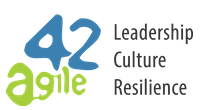About
agile42 enables leaders and their teams to create a resilient organization and a sustainable change process. We equip them with the tools they need daily to grow the business and foster the right organizational culture.
HQ
agile42 Consulting GmbH
Grünberger Str. 54
10245 Berlin, Germany
Grünberger Str. 54
10245 Berlin, Germany
Phone: +49 30 200 53958
Email: [email protected]

Leadership Agility at EWAB
/by Giuseppe De SimoneEWAB is an industrial automation company, founded in Sweden in 1970, but with a global footprint. The organization offers the manufacturing sector conveyor solutions, robot cells, and loading devices.
In 2019, after decades of success and innovation, the company faced challenges regarding what services and products to focus on within unprecedented market conditions. This required a shift towards a more agile approach and coherent culture to become more flexible and resilient.
Read moreCase Study: How to Increase Self-Organization in a Complex Environment
/by Lothar FischmannThe restructuring of an existing value stream represents the greatest possible tactical challenge that managers can face in the context of agile transformation. It directly impacts the organization’s ability to deliver and affects established social structures. It is also on the borderline between two domains: complicated and complex; some aspects of the target structure are known with a fair degree of certainty based on experience, but we cannot predict how the transformation process will proceed or be received by employees.
Read moreWebinar | Implementing Agility at Scale
/by Giuseppe De Simone, Lothar FischmannIn our latest webinar, Implementing Agility at Scale, hosted by Giuseppe de Simone and Lothar Fischmann, we explored the intricacies of scaling. The discussion offered valuable insights into the challenges involved in transitioning to Agile frameworks on a larger scale.
Read moreThe A-Z of Agile: Collabracadabra and the Joygility of Agilicious Teams
/by Lauren EdwardsAre you frazzledazzled, and need a quagmirequasher who loves a bit of collabracadabra to lift you out of a slump? Or perhaps you’re an outoftheboxian who can’t help but yonderize your agile practices? Or maybe you have no idea what we’re talking about – in which case, read on, dear reader! This is a glossary of the most agilicious new vocab to keep you from going kanbananas.
So buckle up those Leaderhosen, and let’s dive in!
Read moreScaling Agile Teams
/by Gregory KeeganWe’ve been working with organizations for over 15 years and despite numerous existing frameworks and models, we’ve learned that there is no silver bullet when it comes to scaling Agile teams. Every context is different and complex. However, we believe that by applying Agile principles and some good practices, any organization can create a framework or model for scaling Agile teams: one that is best adapted to its respective environment and can grow organically. In this guide, we’ll describe a few best practices for scaling Agile teams.
Read moreHere’s Why You Should Learn a New Skill This Year (It’s For Your Brain!)
/by Ebru YalçınkayaThe growth journey of the brain and nervous system begins the moment a fetus is nestled in its mother’s womb. Some of our functions take shape the moment we enter the world, while others unfold during the various stages of life, propelling us into growth and development. Contemporary research indicates that continuous learning supports our brain function well into old age. Even as you read this article and I pen these words, our brain’s neural networks are dynamically evolving, forging new connections and pathways.
Continue LEarningHow to Find a Mentor: Your Guide to Success
/by agile42A mentor is more than just a guide; they are the architects of aspirations, the sounding boards for our ideas, and the well of wisdom to help us grow and learn. But mentoring is a profound exploration of self, ambition, and the power of human connection. It’s not to be taken lightly. So, how do you find a mentor? How do you choose someone who will not only understand your goals and needs but also share your values and inspire your growth? This guide will help you with some practical tips to find the perfect mentor for your path to personal and professional greatness.
Continue Reading28 Ways to Humanize Work
/by agile42As the world becomes more interconnected, people now have job opportunities across the globe. A successful career is no longer about loyalty, climbing the ladder – or even a hefty paycheck and perks. So if money can’t buy you top-tier professionals, how exactly do companies attract and retain top talent?
Continue ReadingSix Workplace Nightmares That’ll Send Chills Down Your Spine
/by agile42Step with us into the world of Workplace Nightmares, where the horrors are real and the stakes are high. Dark secrets lurk behind office doors, and this spooky season, it’s up to you to save yourself. But you’re not alone. We have some tricks to help you survive as you face the ghouls and goblins of the corporate world.
Enter if you dareWebinar | Unraveling Workplace Dynamics: Insights from Humanizing the Workplace
/by agile42, Regina Martins, Birge KahramanIn our recent webinar titled Humanizing the Workplace: The Key to Finding and Keeping Top Talent, experts Regina Martins and Birge Kahraman delved into the essential aspects of fostering a positive work environment. The discussion revolved around the challenges organizations face when transitioning to remote work and the importance of humanizing the workplace when it comes to attracting and retaining top talent. The speakers emphasized the importance of servant leadership, active listening, and the creation of purpose-driven goals to cultivate a healthy and happy workplace.
Continue Reading